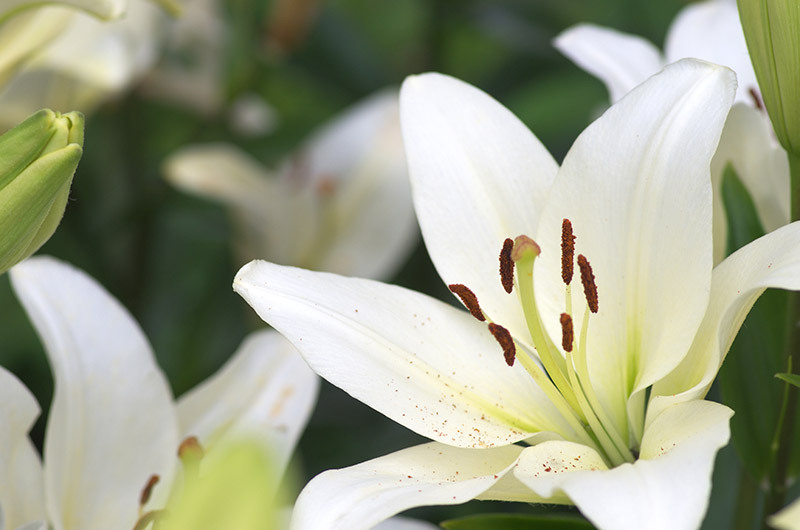The Orchid Whisperer's Care Guide
Posted on 18/08/2025
The Orchid Whisperer's Care Guide: Unlocking the Secrets to Thriving Orchids
If you've ever gazed upon a vibrant phalaenopsis or marveled at the delicate curves of a dendrobium, you know that orchids are far more than ordinary houseplants--they are living expressions of art. But with their reputation for finicky behavior, orchids can intimidate even seasoned gardeners. Fear not! This comprehensive, Orchid Whisperer's Care Guide will demystify orchid care and set you on a path to nurturing these captivating beauties. With expert tips, care checklists, and troubleshooting advice, you'll be speaking the language of orchids in no time.

Understanding Your Orchid: A Brief Introduction
The world of orchids is vast, encompassing over 25,000 species and more than 100,000 hybrids. Each orchid species boasts unique requirements, but some universal care principles will help you keep your orchids healthy and blooming. Whether you're an aspiring orchid enthusiast or an orchid whisperer in training, understanding these fundamentals is crucial:
- Orchid roots need air - most are epiphytes, growing attached to trees in the wild.
- Proper light is essential but varies by species--phalaenopsis, for example, prefer filtered light.
- Watering rhythm is vital: overwatering is the most common killer, while underwatering causes stress and failure to flower.
- Orchids prefer humidity and consistent temperatures for optimal growth.
Choosing the Right Orchid For Your Lifestyle
Your journey as an orchid whisperer starts with selecting a species that matches your environment and routine. Here are some top beginner orchids and their care needs:
- Phalaenopsis (Moth Orchid): Thrives indoors, forgiving, and enjoys indirect sunlight.
- Dendrobium: Prefers bright, diffused light, regular water, and medium humidity.
- Cattleya: Known for showy blooms, needs strong but filtered sunlight and good air movement.
- Oncidium: Also called "dancing ladies," appreciates warmth and light feeding schedules.
Understanding your orchid's origin and habits is half the battle. Read the plant label and research the species' native environment to give your orchid the best life possible.
Lighting: The Lifeblood of Orchid Care
Proper lighting is a cornerstone of successful orchid care:
- East or west-facing windows provide ideal morning or afternoon filtered light for most orchids.
- Too much direct sunlight can scorch leaves--use sheer curtains to diffuse intense rays.
- Insufficient light leads to limp, dark green leaves and a lack of blooms.
Pro-tip: If you see yellowing leaves or brown spots, your orchid may be getting too much sun! Move it slightly further from the window for best results.
Artificial Lighting For Year-Round Blooms
Don't have the right window space? Try LED grow lights! Set them on a timer (12-16 hours per day) to mimic natural cycles and keep your orchids happy all year long.
Watering Wisdom: A Key Skill for Every Orchid Whisperer
Orchids dislike "wet feet", but also resent drying out completely. Finding that sweet spot requires a bit of finesse:
- Check the potting medium - when it's nearly dry but not bone dry, it's time to water.
- Water in the morning to allow leaves and roots time to dry before nightfall, preventing rot.
- Always use room-temperature, non-chlorinated water. Rainwater or distilled water is best.
Watering Methods From the Orchid Whisperer's Playbook
- Soak and drain: Place the orchid's pot in a basin of water for 10-15 minutes, then let it fully drain.
- Never let your orchid sit in standing water! This suffocates the roots and risks rot.
- Frequency varies by environment--in general, water every 5-7 days for phalaenopsis, less often in winter or for other species.
Humidity and Air Circulation: The Ingredients for Orchid Vitality
Orchids are most content in a humid environment with generous airflow. Professional orchid whisperers often replicate these jungle-like conditions for their prized plants.
- Maintain 50-70% humidity using a humidifier, or by placing a pebble tray with water beneath the orchid's pot (never let the pot touch the water directly).
- A small fan set to low speed helps prevent pests and disease by moving air gently through your orchid collection.
- Misting leaves can help momentarily, but doesn't replace true humidity.
Feeding and Fertilizing: The Balanced Diet
Orchids aren't heavy feeders but do need nutrients to flourish. Here's how to deliver the right "diet" as part of your Orchid Whisperer's Care Guide:
- Use balanced orchid fertilizer (20-20-20 or similar), diluted to quarter strength each time you water.
- Fertilize "weekly, weakly" during active growth (spring and summer); reduce to monthly in winter.
- Flush the pot with plain water every 3-4 weeks to prevent salt build-up.
Repotting Orchids: When and How
Healthy roots are the heart of a happy orchid. Repotting provides fresh space and prevents dangerous root rot.
- Repot every 1-2 years, or when the potting material breaks down and becomes soggy.
- Choose a specialized orchid mix--bark, sphagnum moss, or coconut husk chips--for breathability.
- Remove dead roots when repotting for optimal health.
Step-by-Step Repotting Process
- Gently remove the orchid from its old pot and shake off old medium.
- Trim away any soft, brown, or mushy roots using sterilized scissors.
- Place the plant in a slightly larger pot, adding fresh orchid mix around the roots.
- Water lightly after repotting and avoid direct sun for a week.
Blooming Secrets: Encouraging Your Orchid to Flower
Many orchid lovers struggle to rebloom their prized specimens, but the Orchid Whisperer knows: it requires patience--and sometimes a seasonal nudge!
- Adjust day/night temperature--most orchids set buds if night temps drop by 10-15?F for a few weeks.
- Ensure your orchid is healthy, not overfed or underwatered, to trigger next season's blooms.
- Rest period: Some orchids (like dendrobiums) need a dry spell after flowering to simulate their natural cycles.
Recognizing Flower Spikes vs. Roots
It's exciting to see new growth, but is it a root or a spike? Flower spikes are usually flatter at the tip and emerge from between the leaves, while roots are rounder and grow downwards. Patience as you watch for buds is the true mark of an orchid whisperer!
Troubleshooting Orchid Problems Like a Pro
Even experienced orchid keepers face challenges occasionally. Here's your quick guide to diagnosing common orchid issues:
- Yellow leaves? This can signal overwatering, too much sun, or natural aging of lower leaves.
- Wrinkled, leathery leaves? Usually caused by drought or dead roots--check your watering routine and repot if necessary.
- Sticky residue or webbing? Indicates sap-sucking pests like aphids, scale, or spider mites. Treat with insecticidal soap or neem oil.
- Black spots or mushy patches? Sign of fungal or bacterial infection--remove affected tissue and use a fungicide.
Pest Prevention and Treatment
Never use harsh chemicals meant for outdoor use- orchids are sensitive!- Keep leaves clean and dry to prevent infestations.
- Quarantine new plants for a few weeks before introducing them to your collection.

Advanced Tips From a True Orchid Whisperer
Ready to advance your skills? Here are expert-level orchid care techniques to take your collection to the next level:
- Hygrothermographs and humidity meters help you dial in consistent growing conditions.
- Custom potting mixes for specific genera (fine-grade bark for phalaenopsis, coarse for cattleyas).
- Hand-pollinate if you're ready to try your hand at hybridization!
Expanding Your Collection
- Try mounting orchids (like vandas or certain dendrobiums) on slabs of bark or wood for an authentic display.
- Join local orchid societies or online communities for support and rare plant trades.
- Visit flower shows to see incredible varieties and learn from master orchidists.
Conclusion: Embrace the Orchid Whisperer Within
Caring for orchids isn't about striving for perfection, but about understanding and tuning into the plant's natural language. This Orchid Whisperer's care guide has taken you from foundational basics to advanced techniques. Remember:
- Observe your plants regularly - the best orchid whisperers spot subtle changes early.
- Customize your care to fit each species; there's rarely a one-size-fits-all approach.
- Enjoy the journey--every bloom and root is a sign of your patient devotion and new expertise.
Now, with this complete orchid whisperer's care guide, you have the knowledge to nurture, bloom, and showcase these living jewels. Share your successes, learn from your orchids, and become the orchid whisperer you were always meant to be. Happy growing!
Latest Posts
The Orchid Whisperer's Care Guide
Invite joy into your life with the presence of flowers
The Art and Science of Hydrangea Care





